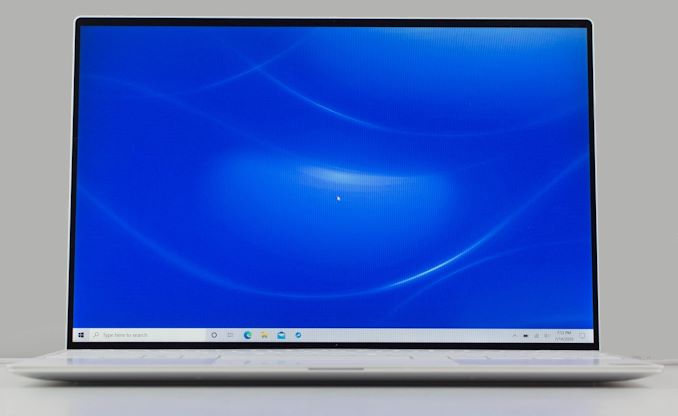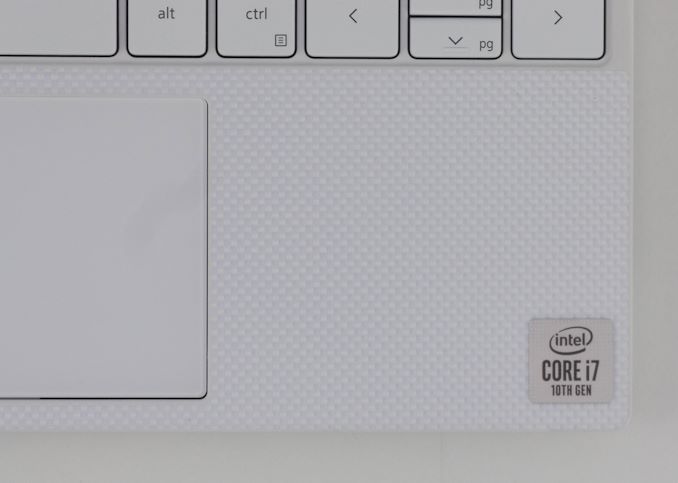The Dell XPS 13 (9300) Review: Return of the King
by Brett Howse on July 16, 2020 10:00 AM EST
Dell changed the Windows laptop market in a single stroke with the launch of the updated XPS 13 back in 2015, ushering in the world of the InfinityEdge display, and moving the entire industry forward. We were fortunate enough to get a chance to check out the precursor to the new XPS 13 back in November, with a review of the XPS 13 2-in-1. Dell had chosen not to rest on their laurels, and the 2-in-1 proved to be one of the best notebooks around if you needed a compact and powerful convertible laptop. Today we are evaluating the traditional clamshell version of the XPS 13, and while it offers many of the same features and design touches, it does so in a more familiar form factor that many customers are going to prefer.
For the 2020 refresh, Dell has made the refreshing move to taller displays, as we saw with the XPS 13 2-in-1. As a result the XPS 13 uses 13.4-inch display panel with a 16:10 aspect ratio, offering more vertical space for getting work done, and some convenient padding to place controls when watching 16:9 content. The larger display fits into a chassis that is actually 2% smaller than the outgoing design, with the new XPS 13 offering a 91.5% screen to body ratio.
This is actually the second time that Dell has refreshed the XPS 13 within the last year. The company previously updated the XPS 13 in August 2019 to use Intel's 10th generation Core processors, but presumably due to limited supply of Intel’s then-new Ice Lake platform, Dell opted to launch that iteration with Comet Lake-U processors. And under more normal circumstances we would have expected Dell to stick with an annual cadence – and thus Comet Lake – for an entire year. Instead, to some surprise, Dell gave the XPS 13 a further mid-generation refresh, launching the Ice Lake-based XPS 13 9300 model that we are reviewing today, and bringing the clamshell XPS 13 to parity with the 2-in-1 version.
The switch from Comet Lake to Ice Lake, in turn, is a significant one. it means the XPS 13 gets Intel’s new Sunny Cove CPU architecture, as well as the much-improved Gen 11 graphics. Dell offers Core i3, i5, and i7 models, with the Core i3 and i5 offering G1 graphics, meaning 32 Execution Units (EUs), and the top-tier Core i7-1065G7 featuring the full 64 EUs on the GPU side. Just as a comparison, the Comet Lake-U only offered 24 EUs of Gen 9.5 graphics, so even the base Ice Lake models still offer a 33% larger (and much newer) GPU than the outgoing models.
The move to Ice Lake also brings some badly-needed LPDDR4X support, which in turn means a 32 GB maximum memory option in the XPS 13 9300, up from 16 GB previously. Although Dell still lists a paltry 4 GB option on their specifications sheet, a quick look at the Dell.com site shows that, at least in the USA, it appears that 8 GB is the new minimum, and that is a welcome change. Offering just 4 GB of RAM in a premium Ultrabook was always a poor choice, even if it did allow Dell to hit a slightly lower price bracket. On the storage front there is more good news, with 256 GB the new minimum, with up to 2 TB available, and all drives are PCIe x4 NVMe offerings.
| Specifications of the Dell XPS 13 9300-Series | |||
| General Specifications As Tested: Core i7-1065G7 / 16GB / 512GB / 1920x1200 |
|||
| LCD | Diagonal | 13.4-inch | |
| Resolution | 1920×1200 | 3840×2400 | |
| Brightness | 500 cd/m² | 500 cd/m² | |
| Contrast Ratio | 1800:1 | 1500:1 | |
| Color Gamut | 100% sRGB | 100% sRGB 90% P3 |
|
| Features | Dolby Vision | Dolby Vision | |
| Touch Support | with or without touch | Yes | |
| Protective Glass | Corning Gorilla Glass 6 in case of touch-enabled model | ||
| CPU | Intel Core i3 1005G1 (4MB cache, up to 3.4GHz) Intel Quad Core i5 1035G1 (6MB cache, up to 3.6GHz) Intel Quad Core i7 1065G7 (8MB cache, up to 3.9GHz) |
||
| Graphics | Intel UHD Graphics Intel Iris Plus Graphics |
||
| RAM | 4 - 32 GB LPDDR4X-3733 DRAM (soldered/onboard) | ||
| Storage | 256 GB PCIe 3.0 x4 SSD 512 GB PCIe 3.0 x4 SSD 1 TB PCIe 3.0 x4 SSD 2 TB PCIe 3.0 x4 SSD |
||
| Wireless | Killer AX1650 Wi-Fi 6 + Bluetooth 5.0 (based on Intel's silicon) Killer AX500 Wi-Fi 6 + Bluetooth 5.0 (based on Qualcomm's silicon) |
||
| USB | 3.1 | 2 × TB 3/USB Gen 3.1 Gen 2 Type-C | |
| 3.0 | - | ||
| Thunderbolt | 2 × TB 3 (for data, charging, DP displays) | ||
| Cameras | Front | 720p HD webcam | |
| Other I/O | Microphone, 2 stereo speakers, audio jack | ||
| Battery | 52 Wh | 45 W AC Adapter (USB Type-C) | ||
| Dimensions | Width | 295.7 mm | 11.64 inches | |
| Depth | 198.7 mm | 7.82 inches | ||
| Thickness | 14.8 mm | 0.58 inches | ||
| Weight | non-touch 1.2 kilograms | 2.64 pounds touch-enabled 1.27 kilograms | 2.8 pounds |
||
| Launch Price | Starting at $999.99 | ||
Dell has gone all-in on USB-C with the new XPS 13, with one port on each side of the notebook. Both feature Thunderbolt 3 with 4 lanes, as well as power delivery for charging. The lack of a Type-A port may inconvenience some, but Dell does include an adapter in the box to assist. Wireless is the Killer AX1650, which based on the latest Intel AX200 wireless adapter – and with Intel purchasing Killer this partnership seems like it is not going anywhere.
If you read our review of the 2-in-1 version of this laptop, you will undoubtedly notice a lot of similarities. As they are from the same product line, that is not an accident: Dell has now refreshed their entire XPS series of laptops with a similar design philosophy. Let’s take a peek at what is new.











224 Comments
View All Comments
gescom - Friday, July 17, 2020 - link
You have a kind of sick desperation in your laugh.https://www.notebookcheck.net/Lenovo-ThinkPad-T14s...
Korguz - Friday, July 17, 2020 - link
gescom, more like a sick desperation to keep praising his god intel, and to bash amd any chance he can.ikjadoon - Thursday, July 16, 2020 - link
IIRC, this was not mentioned by Anandtech, but this laptop (and many, many, many, many) others from the premium Ultrabook category are partnered directly with Intel through the Project Athena program, aka the "Engineered for Mobile Performance" badge you sometimes see.It gives a lot of manufacturing / R&D support while also demanding a minimum set of specifications; I think, in the end, it's a win for OEMs as they get a better product (a virtuous cycle) and they get R&D support directly from Intel on the entire notebook (not just the CPU or wireless).
I think 9/10 premium Ultrabooks are Project Athena certified.
I do believe AMD has launched a rival program with Renoir, but it may take time to gain traction. Tiger Lake vs Zen3-based mobile is going to be exciting and AMD absolutely deserves far better than the relatively average performers they keep getting stuck with.
See Anandtech's reporting here: https://www.anandtech.com/show/14444/intels-projec...
TheinsanegamerN - Thursday, July 16, 2020 - link
I've said for years that AMD needs to partner with a smaller brand like MSI or Clevo and show the world what a proper AMD notebook looks like.I was saying this back in the Llano days where nobody wanted to make a ultrabook style laptop with the A8-3500mx.
jeremyshaw - Thursday, July 16, 2020 - link
They did, with HP, a company with historically strong AMD ties in their consumer line. It didn't go well. Whomever thought bulldozer on netbooks was a good idea, is hopefully no longer calling shots at AMD or HP anymore.eastcoast_pete - Thursday, July 16, 2020 - link
I made the mistake of buying one, and it was bad. The sooner that whole period is buried and forgotten, the better for AMD.lmcd - Thursday, July 16, 2020 - link
If you're referring to the entire Bulldozer family history, I gotta say my Toshiba Satellite with an A8-4500M was actually pretty solid for a number of years. Yea the battery life was trash but performance held up for years, especially with dual-channel memory that I upgraded it to.drothgery - Thursday, July 16, 2020 - link
Depends what they think AMD and Intel will be offering next year, I'd imagine.Most vendors wouldn't have even started designing an AMD premium notebook until after they had real performance and power usage data on Ryzen 4xxx, and even then wouldn't bother unless they were fairly confident Intel wouldn't be able to match it fairly soon.
Cinebench multithread (and other embarrassingly parallel benchmarks) notwithstanding, there's really not much value in more than 4 core/8 threads for most consumers (servers and workstations are another matter); Amdhal's law is still real. But the optics of selling 4 cores vs 8 aren't great, and at least initially, Tiger Lake U will still be a quad core.
Spunjji - Friday, July 17, 2020 - link
"Most vendors wouldn't have even started designing an AMD premium notebook until after they had real performance and power usage data on Ryzen 4xxx"They would have had that data a long time before the platform shipped - Asus couldn't have designed the class-redefining Zephyrus 14 without it. They managed to create a whole new category of gaming sub-notebook, yet most of the larger OEMs couldn't manage to get one into an existing Ultrabook chassis. 🤔
Deicidium369 - Friday, July 17, 2020 - link
Yeah agree there - the OEMs have had access to the specifics of Renoir - but likely will repurpose previous designs, since Renoir is largely like the previous (3xxx APUs, don't know the names) - from an electrical and packaging point of view.I can't imagine having a laptop as a gaming platform - Opus Magnum maybe - but not BF5. But every use case is different - there used to be a DTR slot in my lineup - but not any more.